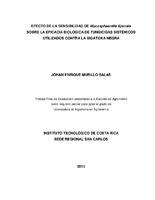Mostrar el registro sencillo del ítem
Efecto de la sensibilidas de Mycosphaerella fijiensis sobre la eficacia biologica de fungicidas sistémicos utilizandos contra la sigatoka negra
| dc.contributor.advisor | Muñoz-Ruiz, Carlos | es |
| dc.contributor.author | Murillo-Salas, Johan Enrique | |
| dc.date.accessioned | 2016-05-13T14:12:31Z | |
| dc.date.available | 2016-05-13T14:12:31Z | |
| dc.date.issued | 2015 | |
| dc.identifier.uri | https://hdl.handle.net/2238/6412 | |
| dc.description | Proyecto de Graduación (Bachillerato en Ingeniería en Agronomía) Instituto Tecnológico de Costa Rica, Escuela de Ingeniería en Agronomía, 2015 | es |
| dc.description.abstract | A two-phase study was carried out to first assess the degree of in vitro loss of sensivity of 11 systemic fungicides use to combat Black Sigatoka, a second phase followed to assess how this diminished effectiveness affect their ability to control the disease in the field. The study was carried out at three different sites with varying levels of strand-sensitivity to fungicides, Santa Clara (a wild strand), La Rita (a moderate resistance strand), and finally Palacios (a resistant strand); and two stages. First, the in vitro sensitivity of the three populations was analyzed by treating ascospores grown on culture media with different concentrations of fungicide (0.001-0.01-0.1-1.0-10 mg L-1). A loss of sensivity was observed to propiconazole, difenconazole, tridemorph, fenpropimorph, spiroxamine, pyraclostrobin, boscalid, thiphanate-methyl and diethofencarb in La Rita and Palacios, a loss of sensitivity to epoxiconazole in La Rita only, and to pirymethanil in Palacios only, with respect to inhibition percentages in distinct doses of 0,01 y 0,1 mg L-1 and CE50. In the second stage of the study, field applications of the fungicides were conducted at 8, 12 and 16 DPI (days post infection) over a previously measured 80cm2 area on the left side of a leaf (25% of the distal portion of the blade, viewed from above). We used a mini sprayer modified for CORBANA according to Calpouzos (1962) and an airbrush (Titan®, modelo BD-132ª), in a random design experiment with a 12x3 factorial arrangement (11 fungicides and mineral oil application), to apply 5 treatment repetitions on 5 test plants for a total of 185 experimental units. The incubation period (PI), amount of time to reach the first stage of infection (PE4), the latency period (PL), the progression of infection severity and the efficacy of the fungicides were evaluated. PI was shorter in the wild strand in all cases, PE4 was longest in the resistant strand, and PL was similar between the wild and resistant strands. The progression of infection severity was very accelerated in the wild and moderately resistant strands, and very slight in the resistant population, which took 24 days longer to reach 100% necrosis in the experimental area on the test plants. This shows a loss of parasitic fitness in that population. In addition, we observed a decrease in the efficacy of the fungicides in the moderately resistant (LR) and resistant population strands (PAL), due to the xvii loss of effectiveness. These results are evidence of a serious resistance problem to the main systemic fungicides in populations of M. fijiensis that is both prevailing and increasing in the banana growing zone of the Caribbean region of Costa Rica. | es |
| dc.language.iso | spa | es |
| dc.publisher | Instituto Tecnológico de Costa Rica | es |
| dc.rights | acceso abierto | es |
| dc.subject | Banano | es |
| dc.subject | Resistencia a los fungicidas | es |
| dc.subject | Sigatoka negra | es |
| dc.subject | Control químico | es |
| dc.title | Efecto de la sensibilidas de Mycosphaerella fijiensis sobre la eficacia biologica de fungicidas sistémicos utilizandos contra la sigatoka negra | es |
| dc.type | proyecto fin de carrera | es |


